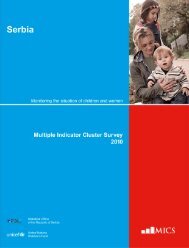Kosovo non-majority communities within the primary and ... - OSCE
Kosovo non-majority communities within the primary and ... - OSCE
Kosovo non-majority communities within the primary and ... - OSCE
Create successful ePaper yourself
Turn your PDF publications into a flip-book with our unique Google optimized e-Paper software.
<strong>Kosovo</strong> Serb <strong>and</strong> Roma students attending Serbian curriculum education. To counter <strong>the</strong>drop-out of Ashkali students, Lipjan/Lipljan municipality finances catch-up classes <strong>and</strong>provides school transport. Gjilan/Gnjilane municipality also facilitates transportation ofRoma children from <strong>the</strong> Abdullah Presheva to <strong>the</strong> Ivo Lola Ribar neighbourhood, where <strong>the</strong>Serbian-curriculum school ‘Vuk Karadžić’ offers classes in Romani language. Themunicipality also pays <strong>the</strong> rent for <strong>the</strong> school premises, located in a private house. Incontrast, o<strong>the</strong>r municipalities of this region where education in <strong>non</strong>-official languages is notavailable 54 have taken no steps to provide alternative solutions.<strong>Kosovo</strong> Turk students in Mitrovicë/Mitrovica receive education in Albanian but <strong>the</strong>municipal director of education is willing to set up classes in Turkish if requested. InVushtrri/Vučitrn, <strong>the</strong> <strong>Kosovo</strong> Turk representative in <strong>the</strong> municipal assembly recentlyrequested bus transportation to enable <strong>Kosovo</strong> Turk pupils’ attendance of a secondaryTurkish language school in Prishtinë/Priština in <strong>the</strong> next school year.Building new schoolsThroughout <strong>Kosovo</strong>, <strong>the</strong> disproportion between a growing number of students <strong>and</strong>insufficient school facilities, combined with admission tests, leads to numerous cases ofexclusion from secondary education 55 that also affect <strong>non</strong>-<strong>majority</strong> <strong>communities</strong>, includingRoma, Ashkali <strong>and</strong> Egyptians. 56 In this context, <strong>the</strong> admission test may result in improperexclusion from secondary education ra<strong>the</strong>r than orienting students towards <strong>the</strong> mostappropriate type of secondary education. International st<strong>and</strong>ards regarding <strong>the</strong> right toeducation specify that secondary education must be “generally available” regardless of <strong>the</strong>students’ apparent capacity or ability. 57 Even when students are admitted, municipalitiesgenerally increase <strong>the</strong> maximum number of students per class, resulting in overcrowding <strong>and</strong>lower quality education. 58 This situation has prompted <strong>the</strong> Ministry of Education’s allocationof € 27,260,000 for <strong>the</strong> construction of new schools in 2009. Only two of <strong>the</strong> planned newschools are for <strong>non</strong>-<strong>majority</strong> <strong>communities</strong>, with an investment of € 234,000, or 0.9 per centof <strong>the</strong> total allocation. 59Measures to integrate children of <strong>the</strong> Roma, Ashkali <strong>and</strong> Egyptian <strong>communities</strong>Following a 2004-2007 catch-up classes programme which targeted some 1,800 Roma,Ashkali <strong>and</strong> Egyptian children in nine municipalities, 60 <strong>the</strong> need for sustained measures toGračanica/Graçanicë. The municipality provides two mini vans <strong>and</strong> covers maintenance costs, while parentspay for <strong>the</strong> driver’s salary.54 Education is not available in Romani <strong>and</strong> Bosnian in Ferizaj/Uroševac where <strong>Kosovo</strong> Bosniaks, Gorani <strong>and</strong>Roma live, <strong>and</strong> in Romani in Novobërdë/Novo Brdo, Štrpce/Shtërpcë,<strong>and</strong> Viti/Vitina.55 In August 2008, 240 out of 698 students were not admitted to secondary education in Shtime/Štimlje, <strong>and</strong> 230out of 582 in Fushë Kosovë/<strong>Kosovo</strong> Polje. Priority is given based on <strong>the</strong> <strong>Kosovo</strong> test results <strong>and</strong> students’marks. Children of poverty-stricken families, in particular Roma, Ashkali <strong>and</strong> Egyptians, are more likely toscore low on admission tests <strong>and</strong>, <strong>the</strong>refore, particularly vulnerable to exclusion.56 In September 2008, an Ashkali student was not admitted to <strong>the</strong> secondary school in Podujevë/Podujevo due to<strong>the</strong> test results <strong>and</strong> enrolled later upon intervention of <strong>the</strong> Ministry of Education.57 Article 13.2(b), International Covenant on Economic, Social <strong>and</strong> Cultural Rights; Economic <strong>and</strong> SocialCouncil, Committee on Economic, Social <strong>and</strong> Cultural Rights, E/C.12/1999/10, General Comment on <strong>the</strong>Right to Education, 08/12/1999, paragraph 13.58 The number of students per teacher is 32. In Fushë Kosovë/<strong>Kosovo</strong> Polje it was increased to 37, <strong>and</strong> classesare generally of 45 students. In Shtime/Štimlje, <strong>the</strong> threshold was augmented to 44.59 Law on Budget of <strong>Kosovo</strong> for Year 2009, 30 December 2008; Tables of budget of <strong>Kosovo</strong> for 2009; Specificbudget items: “construction of <strong>primary</strong> school for minorities,” Euro 200,000; <strong>and</strong> “construction of <strong>primary</strong>school in Bostane/Bostan” (Novobërdë/Novo Brdo), Euro 34,000.60 Prishtinë/Priština, Lipjan/Lipljan, Suharekë/Suva Reka, Pejë/Peć, Istog/Istok, Prizren, Shtime/ Štimlje,Gjakovë/Đakovica <strong>and</strong> Fushё Kosovё/<strong>Kosovo</strong> Polje.13
















